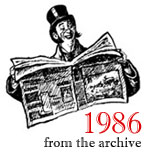
The Vatican’s New Look at Liberation Theology
ON THE RELATIONSHIP OF THE CHRISTIAN TO THE WORLD
Confusion about what is clear is one of the hallmarks of contemporary Catholic controversy. Whether you blame the Father of Lies or mere human perversity, ideas that are transparent (even though they may be debatable) have been repeatedly obscured in the intra-Church quarrels of the past quarter-century. This is particularly so when it is a question of teaching by Rome: outrageous howlers routinely pass unchallenged as fair summaries of what the Pope and his associates have said. Perhaps it is easier to dispatch an intellectual adversary whom one has misrepresented.
These gloomy observations fully apply to the debate over liberation theology. One can only hope they will not also prove true of the Instruction on Christian Freedom and Liberation, published in April by the Holy See’s Congregation for the Doctrine of the Faith, headed by Joseph Cardinal Ratzinger.
The Instruction is a long, complex, sophisticated document which will very likely keep students of Catholic social doctrine, the religion and politics debate, and other elements of ecclesiastical controversy occupied for a long while to come. It specifically invites local interpretation and application. It would be an admirable document for a Church and a world marked by intellectual honesty and determination to be guided by the Church’s magisterium. Whether it will work well in the Church and the world as they actually are is, to say the least, uncertain. The first indications are not especially encouraging.
Most of the American media gave qualified approval to the document when it appeared, but many seemed also not to understand very clearly what it is about. Considering the lumps Cardinal Ratzinger has taken lately as a surrogate for Pope John Paul II, even confused approval may be progress. Still, one goes on hoping for something better. A positive but patronizing editorial in the New York Times of April 10 exemplifies the problem. I do not mean to single out the Times for special criticism but only to suggest that, in this matter as in others, America’s newspaper of record is representative in its faults as well as its virtues.
You May Also Enjoy
Moliere’s Bourgeois Gentleman was amazed to learn that all his life he had spoken prose.…
If states offer school vouchers to parents, then states should require teacher salaries commensurate with those of public-school teachers.
For a person with a strong social conscience, chastity is a mature response to a great evil. It is a form of rebellion.

